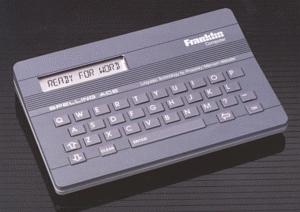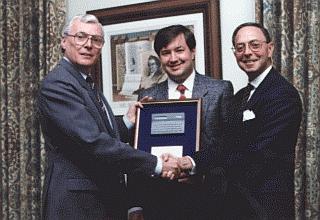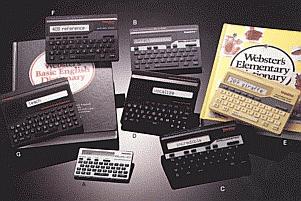
The pocket speller model SA-95
| Hand-held electronic book, Franklin Electronic Publishers | 1986-... |

Description: I first sketched software and physical design for a hand-held speller while at Berkeley in 1979. At that time it would have cost roughly $500 to manufacture. The SA-95 speller shown above was introduced in 1990 with a manufacturing cost of less than $15. It uses a 6502 microprocessor (the same as an Apple-II) on a custom Franklin-designed VLSI chip, and is powered by a single lithium cell. Our design objective was to create a jewel -- a product which would stand out on a crowded shelf of low-cost calculators. So we choose to make the product a bit thicker than most so that moving rubber keys could be used. The LCD display is covered with a curved lens which slightly magnifies it. It's not easy to see in the photograph, but the case itself is clear, with metal plates attached to the front and rear.
Background: Two models, the SA-88 and SA-98 preceded the SA-95. The SA-88 was first and was soon replaced by the second. It retailed for $89 and the reception it received upon introduction convinced us all that the market was ready for hand-held devices beyond simple calculators. The SA-98 refined the design and rapidly became the flagship Franklin product.

The spellers all contain an 80,000 word English lexicon edited by Merriam-Webster based an original compilation by Proximity Technology. The spelling correction algorithm considers both typographical and phonetic misspelling. Both the lexicon (in highly compressed form) and the software reside in 128K bytes and are stored in a ROM chip. Several games such as Hangman are included.


A number of thesaurus products were introduced at slightly higher prices. These included the Proximity/Merriam-Webster thesaurus developed for the software word processing industry. Many other speller models are not mentioned including some that were combined with a calculator. An interesting and still popular variant was the CrossWords product. This speller replaced the standard English lexicon with a much larger one designed for use in solving crossword puzzles. The user types "?" for unknown letters. If the proper word still doesn't appear the "second-guess" key ( Electronic word selection machine (patent) ) is pressed. It displays additional words that differ in one position from the user's query. Pressing again allows differences of two -- and so on.